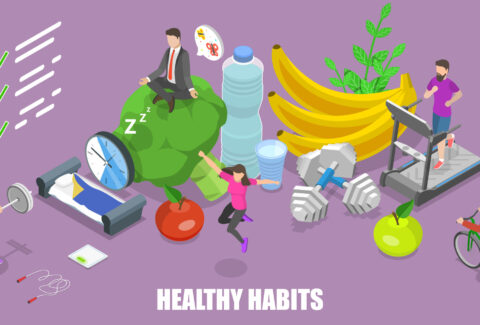Science of Habit Formation: How to Make Healthy Changes Stick
Have you ever started a new habit—like exercising, eating healthier, or getting more sleep—only to fall off track within weeks? You’re not alone. The struggle to maintain new habits isn’t about willpower—it’s about strategy.
Understanding how habits form and how to design them for long-term success can help you create lasting changes. If you’ve ever struggled with making better food choices (From Fast Food to Fresh), improving sleep (The Sleep Cheat Code), or managing stress (Why Stress Sucks for Your Health), you’ll see how simple habit shifts can make all the difference.
Let’s break down the science of habit formation and how you can use it to transform your daily routines.
The Habit Loop: Cue, Routine, Reward
Your brain doesn’t randomly decide to repeat behaviors—it follows a pattern. Every habit consists of three core elements:
1️⃣ Cue – The trigger that reminds your brain to act (e.g., waking up, feeling stressed, seeing a notification).
2️⃣ Routine – The action itself (e.g., scrolling social media, snacking, working out).
3️⃣ Reward – The payoff your brain receives (e.g., dopamine hit, relaxation, energy boost).
“Habits aren’t broken; they’re replaced. Design your environment to make good habits easier and bad habits harder.”
For example, if you’re trying to get better sleep, creating a habit loop around nighttime wind-down routines—like dimming the lights and putting screens away—can make sleep easier. Learn more in The Sleep Cheat Code.
Why Most Habits Fail (And How to Fix It)
We often fail at forming habits because we rely too much on motivation, which is unpredictable. Instead, habits stick when they’re:
✔ Small – Start with 5-minute actions instead of massive lifestyle overhauls.
✔ Obvious – Make habits easier by designing your environment (e.g., keep a water bottle nearby to drink more water).
✔ Rewarding – Find ways to make habits enjoyable, not a chore.
“Success comes from consistency, not intensity. Small actions, repeated daily, lead to big results.”
Struggling with too much screen time? One simple way to build a better habit is to set tech-free zones in your home. Read more about Digital Detox: How Reducing Screen Time Can Improve Your Sleep, Mood, and Focus (used once).
The Two-Minute Rule: Make It So Easy You Can’t Say No
If a habit feels overwhelming, shrink it. The Two-Minute Rule states: “Any habit should take less than two minutes to start.” This helps your brain bypass resistance.
🔹 Want to exercise? Start with one push-up per day.
🔹 Want to journal? Write one sentence before bed.
🔹 Want to read? Open a book and read one paragraph.
“Once you show up, momentum takes over. The hardest part is starting.”
If you’re working on improving focus, reducing distractions like excessive screen time is crucial. Learn how in How to Reduce Digital Distractions and Improve Focus.
Habit Stacking: Attach New Habits to Existing Ones
One of the easiest ways to make habits stick is habit stacking—attaching a new habit to something you already do.
🛁 After I brush my teeth, I will drink a glass of water.
🏃 After I put on my running shoes, I will stretch for 30 seconds.
📖 After I make my bed, I will read one page of a book.
“Tie new habits to existing routines, and they become second nature.”
For more ideas on small, sustainable habit shifts, explore 5 Small Changes to Build Healthy Habits That Last a Lifetime.
Design Your Environment for Success
Your environment shapes your habits. Instead of relying on willpower, design your space to make good habits automatic and bad habits inconvenient.
Make Good Habits Easy:
✅ Keep healthy snacks visible, so you grab them instead of junk food.
✅ Place a yoga mat where you’ll see it, reminding you to stretch.
✅ Set a glass of water by your bed for morning hydration (Why Staying Hydrated is a Game-Changer for Your Health).
Make Bad Habits Hard:
❌ Put your phone in another room before bed.
❌ Uninstall distracting apps or turn off notifications.
❌ Store junk food in hard-to-reach places.
“Make good choices easy, and bad choices hard—your habits will follow.”
The Role of Accountability and Tracking Progress
Tracking progress keeps you motivated. Even small wins reinforce habits.
📅 Use a Habit Tracker – Mark an ‘X’ on a calendar for every successful habit day.
👥 Find an Accountability Partner – Commit to a habit with a friend for extra motivation.
🎯 Celebrate Wins – Acknowledge progress, no matter how small.
“Tracking makes habits visible—when you see progress, you stay motivated.”
If you’re trying to eat healthier, tracking your food choices can help. Learn how to make better swaps in From Fast Food to Fresh.
What To Do When You Slip Up
No one is perfect, and breaking a habit streak doesn’t mean failure. The key is to never miss twice. If you skip a habit one day, get back to it the next.
🚫 Don’t let a single missed day become a new habit.
🚀 Aim for progress, not perfection.
💡 Adjust your approach if needed—habits evolve over time.
“Missing once is an accident. Missing twice is the start of a new habit.”
For tips on overcoming setbacks, see Why Stress Sucks for Your Health and How to Manage It—because stress often derails new habits.
The Bottom Line: Habits Are Systems, Not Goals
A digital detox, better sleep, healthier eating, or daily movement—every positive change begins with habits.
The secret isn’t in setting goals but in building systems that make success inevitable. If you focus on the process, results will follow.
If you’re ready to take control of your habits, start with one small change today. Need ideas? 5 Small Changes to Build Healthy Habits That Last a Lifetime is a great place to begin.
What’s one tiny habit you’ll start today? Drop it in the comments and let’s build better habits together! 🚀






